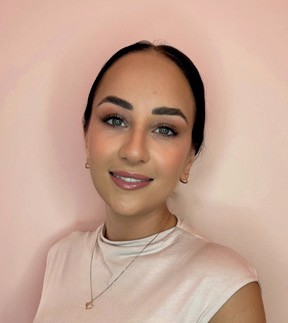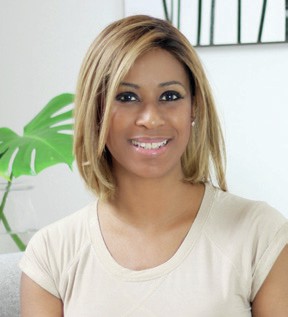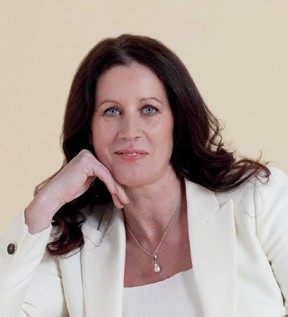BUSINESS TIPS
Ask the Experts
Our beauty experts answer your questions about every aspect of running a salon or spa business
How can I incorporate devices in spa treatments while retaining a relaxing atmosphere for clients?
Over the years, I have been lucky enough to manage and help in the start-up of all beauty sectors, from aesthetics to salons and spas.
When I began to assist in the set-up of spas, one of my thoughts was around the lack of results-driven treatments in this sector. I had been to many spas, and they were all very beautiful and I always emerged relaxed, but why couldn’t I expect more from it?
The modern-day spa day is changing and to keep up with the expectations of our clients, we need to change too – but this doesn’t mean we have to sacrifice the experience that the very word “spa” brings with it.
Here are some tips for successful machine integration:
• Choose your machine wisely – don’t just choose what is on trend; align it with your core values and mission, and test out as many as you need to in order to find the perfect match.
• Have a solid marketing and launch plan. If your main client base is spa-goers, educate them about the benefits and show the level of relaxation they will still receive.
• Always incorporate an element of massage with your machines, be it a hand and arm massage, scalp, face or feet – and slow it down.
• Only bring in the lighting required for your machine when you need to and switch it off after.
• Prepare as much of the machine as possible prior to the treatment to avoid unnecessary noise.
Central to the success of machine integration is client education. Our role as spa professionals is to explain the benefits that devices bring to the table while ensuring that the client experience remains at the forefront.
Even cleansing during a facial should feel like a massage – agreat example is the Opatra Aqua Spectra machine, which exfoliates the skin and provides tightening with radiofrequency. The delicate process, accompanied by therapists’ skilled hands, paints a picture of technology working hand-in-hand with relaxation.
In conclusion, the incorporation of devices into spa treatments is not just a trend but an evolution. The key is to balance the attraction of innovation with the solace of relaxation. Devices enable us to go beyond the conventional and offer our clients an experience that resonates deeply – aharmony of technology and tranquility that goes beyond the ordinary.

Melissa Mitchelmore is a beautytherapist with 13 years of experience in the industry, with previous roles including assistant general manager and spa manager. She is currently a brand ambassador for Opatra.
How can I help to treat my clients’ pigmentation with topical products?
Pigmentation refers to the colouring of the skin, which is influenced by the production of melanin – the pigment responsible for giving us our unique hues. Melanin is one of your skin’s defence mechanisms, and it has two roles; to protect your skin from UV rays and to mop up free radicals from pollution and the environment.
Melanin is produced by melanosomes. When the skin is under attack, it triggers a natural chemical response by an amino acid called tyrosine and an enzyme called tyrosinase. Together, they activate melanosomes to form melanin, and the cells then transform into melanocytes. The melanin is then delivered to the keratinocytes (skin cells). The quantity and quality of the melanin depends on skin colour.
Fair skin mainly has pheomelanin, which are the orange/red pigments, giving a light golden tan. In very fair skin, melanin cannot reach the skin surface. This skin, when exposed, often goes red but then goes white again. Darker skins produce eumelanin – the brown/ black pigments. The darker the skin, the more natural protection we have. Melanocytes are very sensitive, and they have a “good memory” system. For instance, if you have been burnt by the sun in the past, the next time the area is exposed, the melanocytes will give more melanin to the affected areas, making the dark patches appear.
As a skincare specialist, helping your clients treat pigmentation with topical products requires a comprehensive understanding of the different types of pigmentation, including hyperpigmentation (excess melanin production), melasma (hormonally induced pigmentation), post-inflammatory hyperpigmentation (PIH), and sunspots (UV-induced pigmentation). Identifying the specific type of pigmentation your client has is crucial to tailoring an effective treatment plan.
Pigmentation can be treated with topical products but there is a caveat. If we only target the pigmentation, the results will be minimal, and this can lead to customers being disappointed and disillusioned with topical products. At Katherine Daniels, we believe in the skin first, symptoms second philosophy – pigmentation shows that the skin is vulnerable, so we need to strengthen the skin first, then treat the pigmentation symptom second.
Treating dryness, dehydration and sensitivity first will aid the skin in functioning to its full potential. This can be achieved by a thorough homecare routine. Using products to strengthen vulnerable skin first will give you a better result when targeting the pigmentation. The strengthened skin is then able to accept and use the active ingredients to treat the pigmentation marks.
If we only try to treat the pigmentation, we will only get a minimum result. We need to strengthen the skin first then protect and defend the skin against further harm. One of the important things to remember when trying to prevent or treat pigmentation is that you also need to add in powerful antioxidants, as reducing melanin production means you have less defence against free radical attack.

Donna Tait is a beauty therapist and trainer, and the co-founder of skincare brand Katherine Daniels.
How can I personalise treatments for different skin tones?
The world is a rich tapestry of diverse skin tones, each with its unique set of needs and concerns. People with darker skin have more melanin compared to those with lighter skin. Different skin tones impact the type and severity of skin problems individuals face, as well as their treatment. Let’s dive into the concerns and treatments for a few skin types.
South Asian skin
Common concerns:
• Hyperpigmentation and melasma are common in South Asians due to their higher melanin content, which can lead to increased pigmentation.
• Acne is a common issue, often due to oily skin and increased sebum production. It can result in inflammatory lesions that, when healed, may leave behind postinflammatory hyperpigmentation (PIH).
Recommended treatments:
Treatments that inhibit melanin production, like hydroquinone and kojic acid peels, can be effective. Both work by inhibiting tyrosinase, an enzyme involved in melanin production, lightening hyperpigmentation and melasma. Laser treatments, specifically Nd: YAG, could target deeper pigmentation. Microneedling with serums containing vitamin C or hyaluronic acid can help with PIH and rejuvenation. Topical niacinamide can also be helpful.
East Asian skin
Common concerns:
• East Asians also frequently face melasma due to hormonal changes or sun exposure.
• Freckles are small, tanned spots on the skin and are often genetic in East Asians. They can increase in number and become darker with sun exposure.
• Sensitive skin: East Asians may have a compromised skin barrier, making skin more prone to irritation and allergies.
• PIH is also a common concern due to the skin’s propensity for hyperpigmentation after inflammation.
Recommended treatments:
Gentle treatments are more suitable due to skin sensitivity, such as LED light therapy (blue for acne, red for antiageing). Enzyme peels can provide gentle exfoliation. For melasma and freckles, Q-switched and ND: YAG lasers or IPL can be effective as they target melanin, breaking down pigmentation. Alpha arbutin is a helpful topical product.
African skin
Common concerns:
• Keloids are raised scars that extend beyond the original injury. African skin is more prone to keloids due to the strong inflammatory response.
• African skin is prone to PIH due to high melanin content.
• Pseudo folliculitis, commonly known as razor bumps, occurs when shaved hair grows back into the skin, causing inflammation.
Recommended treatments:
Laser treatments can help manage keloids by flattening them and reducing redness. For PIH, retinoid creams and azelaic acid peels can be effective. Nd: YAG laser can be used for treating pseudo folliculitis.
Don’t miss Antonia Burrell at Olympia Beauty, where she’ll be talking about “Diverse and inclusive beauty: how to treat all skin tones with confidence” on the Advanced Beauty Stage at 2pm on Sunday, October 15.

Antonia Burrell is a Babtac-accredited practitioner with two decades of experience. She’s an associate lecturer in the chemistry of aromatherapy at the London College of Fashion, and founder and chief executive of Antonia Burrell Holistic Skincare.
What are the benefits of incorporating heat into my treatments?
Heat has long been used for health reasons, dating back thousands of years. A Greek philosopher famously recognised the power of heat healing when they said, “Give me the power to produce fever and I will cure all disease.”
Thermal and mud baths were among the most common ancient Greek practices, but they would even enjoy hot air caverns linked to volcanic sources from time to time to get their hit of heat.
Over the years, recognising the power of hot water and steam for muscles, skin and pain relief, many cultures began to adapt this type of heat therapy to suit their own preferences and daily life. For example, the Finnish sauna, the Japanese onsen and the Turkish hammam were born, and the list goes on.
Traditionally, heat therapy was used to cure specific ailments and illnesses, including digestive issues, arthritis and neuritis. But with more and more spas and wellness practitioners experimenting with new wellness experiences and ways to incorporate heat into their offerings, this type of therapy is now widely used for general relaxation.
It’s no secret that sweating in a sauna does wonders for our health, with heat increasing circulation in the body to help move the beneficial nutrients between the joints and muscles. But these days, the choice doesn’t stop there. Hot stone massages, foot spas, tepidariums, salt steam rooms, sanariums – you name it, a spa has likely tried it.
In the ever-evolving world of wellness, even with the spa treatments and wellness experiences that don’t directly incorporate heat, spas are continually exploring the option of what we call treatment add-ons. This allows hypercustomisation and elevates the whole experience for the client.
Something as simple as a heated eye mask or warm scalp towel can make all the difference to both the treatment and its overall benefits.
Lava Shells are a natural successor to the original hot stone treatment, delivering both deep results with curved edges to reach more deeply into the muscles, while self-heating eye masks, such as Sensory Retreats’ Divine Eye Masks, can easily be incorporated into any aspect of the spa experience, whether lounging the pool, unwinding in the sauna or enjoying a float tank.

Clare Anderson is a trained therapist and the founder of Sensory Retreats and Shared Beauty Secrets, which has trained over 10,000 therapists at over 2,000 spas and salons in the UK and Ireland.